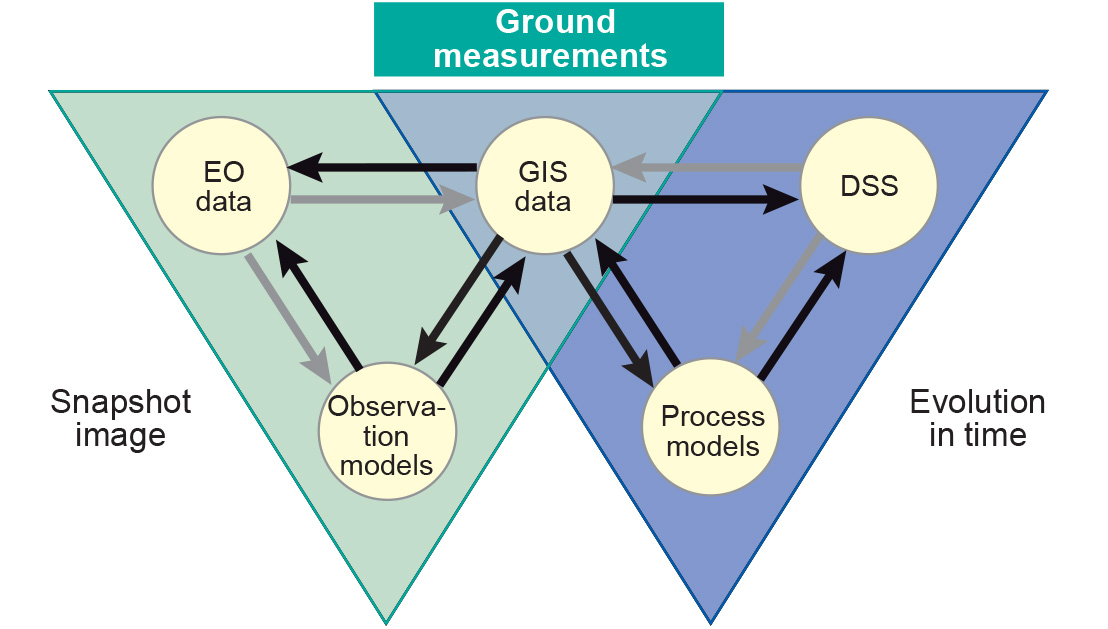Observation model
Introduction
Radiative transfer models that describe the relations between physical and biochemical
properties of objects on the one hand, and observed radiation on the other, can be
called observation models.
Explanation
To study the relations between object properties and observed spectra, radiative transfer
models have been developed. These models enable searching for optimum observation
conditions and they can be used for the development of algorithms to retrieve
physical properties of observed objects on Earth.
Radiative transfer models that describe the relations between physical and biochemical properties of objects on the one hand, and observed radiation on the other, can be called observation models.In an observation model, the characteristics of the observing instrument, the observational conditions and the observable object’s properties all play prominent roles. Characteristics of the instrument and the observational conditions include the viewing direction, the spectral bands used and their spectral and spatial resolution. Object properties are, for instance, canopy LAI (leaf area index) for vegetation and suspended sediment concentration for water. Figure 1 illustrates the effect of vegetation canopy LAI on the observed reflectance spectrum in the visible, near infrared and shortwave infrared ranges. These simulations have been carried out with the well-known SAIL model. It demonstrates clearly that for the observation of high LAI values, especially the near infrared part of the spectrum is more sensitive to LAI than the visible part.

as a function of LAI
In the thermal infrared spectral region, surface temperature and emissivity are important object properties. Examples of other well-known physical theories in which the observation conditions play a central role are, for instance, Einstein’s theory of relativity and the theory of quantum mechanics. Planck’s law of black-body radiation can also be considered an observation model as it predicts the observed radiation spectrum as a function of the object’s temperature.
Most observation models relevant for remote sensing applications describe scattering and absorption of radiation in various media, such as the atmosphere, water bodies, snow, plant leaves and vegetation canopies. They might also include the scanning mechanism and other observational and instrumental properties, such as viewing direction, spectral and spatial resolutions, and signal-to-noise levels. Observation models may also be coupled. This is very useful, since most remote sensing observations involve a mix of several media, e.g. the combination soil–leaf–canopy and that of sea bottom–water–atmosphere.
Examples
Observation models and process models can supplement each other to enhance the quality of the interpretation of remote sensing data and to fill gaps in time that occur when observations are not possible owing to clouds or some other cause. Figure 2 shows possible interactions of observation models and process models with EO data and existing geographic information (GIS and ground measurements, supplemented with decision-support systems (DSSs)). A central role is played by the GIS database, which provides a common geographic reference. The diagram shows how Earth observation data provide a series of snapshots of the situation on the Earth’s surface (green triangle) and how this monitoring of the surface feeds a process model that is updated with actual data (purple triangle). The process model provides information to the decision-support system, which supports management actions aimed at controlling/mitigating the process. A good example of this is a water management system, in which one might decide to allocate water for irrigation if the observed vegetation appears to suffer from drought stress.

Outgoing relations
- Observation model is based on Retrievability
Incoming relations
- Observable is used by Observation model
- Spectral reflectance curves is used by Observation model